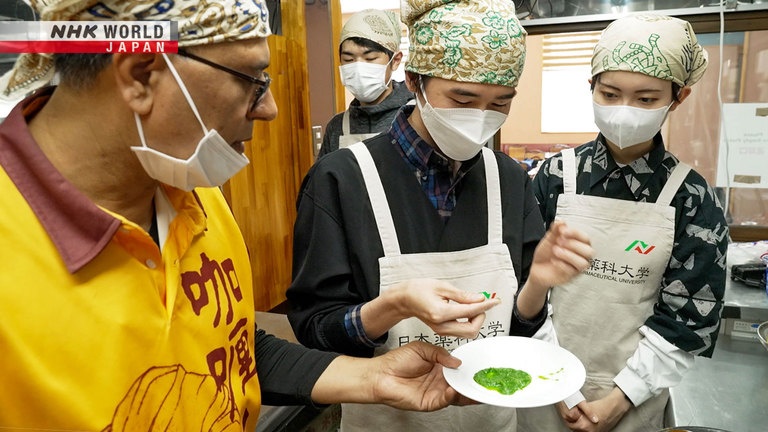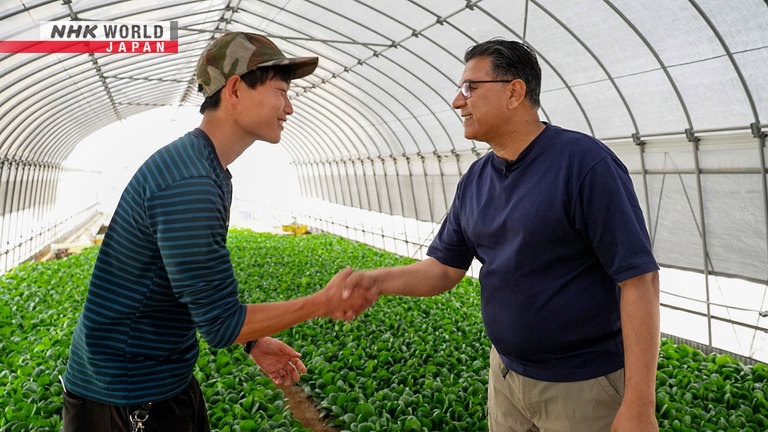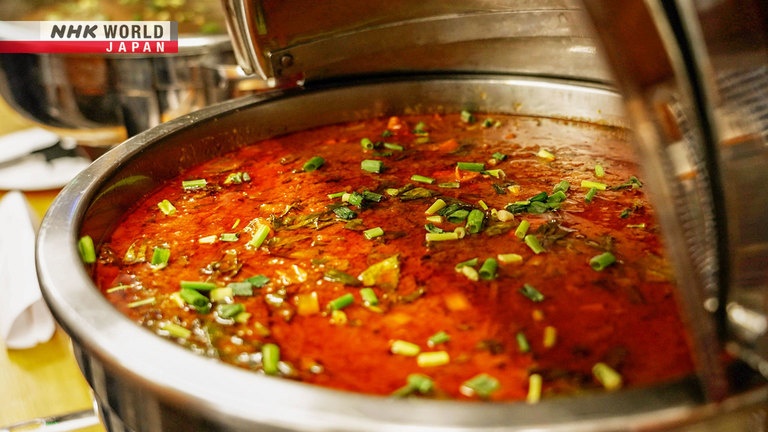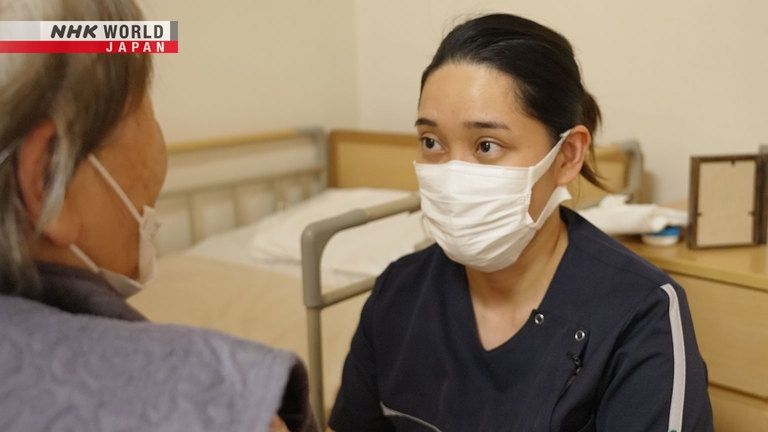In Search for the Taste of Yashiostan
Home to a large Pakistani community, the city of Yashio in Saitama Prefecture is nicknamed Yashiostan. It's here that we meet Mian Ramzan Siddique, who opened a halal food court, a place for his fellow Pakistanis and the locals to gather. But he's having difficulty drawing in Japanese customers. To change that, he's developing a curry recipe featuring both local and Pakistani specialties. Join us for a taste! We also meet Filipino Manalo Lhee Mayrene, a caregiver at a facility for the elderly in Nagoya.




Transcript
Where We Call Home.
At this newly opened commercial facility, one business owner hopes to build connections in the local community
...with curry!
Mian Ramzan Siddique, from Pakistan.
In the city of Yashio, where many of his fellow Pakistanis live,
he wants to make the facility a place where they and the local Japanese residents can meet.
I love living here in Yashio.
The food is great.
But the center has yet to build a Japanese clientele.
Siddique's attempting to unite both communities through food:
with an original curry that would feature local products.
And thus begins a long process of trial and error to find the perfect flavor.
Something's missing.
Let's join Siddique in his search for a tasty way to enliven his town of adoption.
Yashio City in Saitama Prefecture.
It's a commuter town about a half-hour train ride from central Tokyo.
It's also the home of many Pakistanis.
In fact, it's earned the nickname of Yashiostan.
The local mosque is frequented by many Muslims.
This March, a commercial facility combining a food-court and shopping area
catering to Yashio's Islamic community opened its doors.
Pakistani business owner Mian Ramzan Siddique says setting up this center has been his dream.
Including parking, the site occupies about thirteen hundred square meters.
Here is the shopping area.
All of the products here are halal.
We import them directly
or purchase them from other companies.
We carry 2,600 products.
In addition to food products that follow halal standards,
they also sell clothes.
These are about one US dollar a piece.
These Pakistani sweets are difficult to find in Japan.
The store sells them at a reasonable price.
I live in Yashio.
These shops are great.
Everything's halal, so we're thankful
this commercial center opened here.
Siddique put special effort into the center's halal food court.
He began the project with the hope of creating a place
for the Muslim and Japanese communities to meet and socialize.
Including the popular street dish Kata Kat,
the food court has on offer all kinds of Pakistani delights.
There are also Japanese quintessentials like "ramen,"
as well as Chinese and Malaysian cuisine - all of which are halal friendly.
I really want this to be a gathering spot
for Japanese and Pakistanis to meet.
It's got room for 100 customers
and a high ceiling.
I wanted to create a convivial atmosphere
for people to enjoy a meal together.
Siddique came to Japan in 1995 and started a Pakistani restaurant
that led the way to a variety of businesses.
Currently, he also deals in the import and sales of spices and produce from his homeland.
I bought some fruit.
Siddique and his wife have four children, and last year, his parents left Pakistan to move in with them.
His wife Sabra has been diligently taking care of the family.
Without her hard work raising our kids,
I wouldn't be able to work.
I'm so thankful.
Recently, Siddique's work for the food court keeps him away from his family.
He works on Sundays, too.
He's never at home.
Siddique is so hard working.
I'm proud of him.
During the recent month of Ramadan, the newly-opened food court was bustling with diners at night.
And Siddique was busy attending them.
However, almost all patrons are fellow Pakistanis.
During daytime hours, no Japanese customers show up.
I want it to be a place people
from different countries can share.
Especially, I hope children
of every nationality will come.
As a Muslim, I want the food court
to be a social hub.
However, to the Japanese residents of Yashio,
the Pakistani restaurants in the area appear somewhat unwelcoming.
The restaurants feel a bit intimidating.
The entrances seem uninviting.
I knew the Pakistani shops
but I'd never been to any.
I was reluctant.
Siddique seeks the counsel of Kondo Kazuhiko,
a local real estate broker who's been very supportive over the years.
I want people to enjoy the flavors
of Pakistan and local Yashio specialties.
I'm looking for some idea
that would combine the two.
Siddique takes Kondo to a long-standing Pakistani restaurant.
Together with his friend Ali, the restaurant owner,
they're going to brainstorm some ideas.
Starting a business is hard.
It's with the help and advice of Japanese
people that I got where I am today.
Ali understands the importance of seeking input from the Japanese locals.
Kondo suggests creating a dish that would incorporate local Yashio specialties.
Adding local ingredients would be nice.
Now "edamame" soybeans are in season.
Adding "edamame" could work.
Develop a relation with farmers.
If more regular customers come,
business will pick up.
They come up with the idea to create an original curry recipe with locally-grown produce.
Siddique visits a university that's also in Saitama prefecture.
Good morning.
We want to create curry with vegetables
produced in Saitama.
This university works on similar projects.
So, here I am.
Students at the university collaborate with local farmers
to develop products like jam, beer and tea that showcase their produce.
Hi!
I want to create a special curry.
Something that's healthy, made with
produce like vegetables or fruit.
With the Pakistani spice he imports,
Siddique hopes to combine Yashio produce to make curry that's as healthy as it is tasty.
Yashio is famous for a vegetable
called "komatsuna."
It helps cool the body's temperature.
It would balance out nicely with
the warming effect of the spices.
I've used "komatsuna" before.
It can't be found in Pakistan,
India or Bangladesh.
"Komatsuna" would be nice.
Siddique pays a visit to a "komatsuna" farmer in Yashio.
Hi. Pleased to meet you.
This farm has been growing "komatsuna," or mustard spinach, for more than 200 years.
Used in "miso" soup or various sauteed dishes,
it's an ingredient well-loved by Japanese people.
I didn't know it was grown in Yashio.
May I?
It's delicious.
With olive oil or salt and pepper,
it could be eaten raw.
It can.
We don't have this back home.
Siddique found the ingredient he was looking for.
It's exciting.
I'm thrilled to have found
a local business partner.
Thank you so much.
Let's do our best!
A week has passed.
Siddique invited the university students over to the halal food court
for some experimenting.
I'd like to use "komatsuna" from Yashio.
Ideally, I want to create
two or three recipe variations.
How about making "komatsuna" paste?
You think paste would work?
- A nice bitterness.
- It's good as is.
They also try it roughly cut.
Maybe if we try cutting up
larger pieces, too?
To attenuate the spiciness a bit for the Japanese palate,
they try adding apples and bananas.
The basic sauce is prepared with a secret blend of spices from Siddique's shop.
With the "komatsuna" paste and the chopped up "komatsuna," they create two variants.
How's the taste?
That's not it.
The fruit paste itself was tasty.
Something's missing.
There's too much apple.
It's too sweet.
The "komatsuna" and apple clash.
It's not good.
Then, one of the students asks a question.
Did you have any other ideas for
a fruit we could use?
Yes, Pakistani mangoes.
Mangoes in curry? I can't imagine.
I've never tried it...
But if you say so.
There is no "komatsuna" in Pakistan,
and no mangoes in Japan.
Combining the two could be interesting.
For Siddique, mangoes have a special significance.
He once expanded his restaurant business to reach a total of twenty-six locations in Tokyo and the surrounding regions.
However, in the wake of the 2011 earthquake and "tsunami," many Pakistanis working for him left Japan,
negatively affecting the quality of the dishes served at the restaurants.
I couldn't keep the company going.
Things weren't working out, so I thought
I had no choice but to shut it down.
That's when he noticed mangoes had been gaining in popularity in Japan.
And so, he put the fate of his business in the importation of Pakistani mangoes.
They're really tasty.
He found fellow Pakistani investors and made use of Japanese know-how to import mangoes.
Siddique's company was saved.
Here, Pakistani mangoes.
Development of the new curry has entered a decisive and exciting stage.
A collaboration between mangoes from Pakistan and Yashio-grown "komatsuna."
They try a version with the students' idea of "komatsuna" paste
and one with roughly cut pieces to find the perfect combination.
Curry has to be well mixed, like this.
Will the Japanese like the results?
The trial-and-error process continues.
To promote the new curry, Siddique decided to hold a free tasting session.
He had a total of one thousand fliers printed to announce the event.
To hand them out, he enlists the help of Japanese locals and fellow Pakistanis.
Please come try our new curry.
His son Hamdan goes door to door.
It's on the 7th. Please come.
It was me who rang your doorbell.
This shop is run by a local farming cooperative that introduced the "komatsuna" farm to Siddique.
"Komatsuna" from Yashio.
- Yashio curry with "komatsuna" and mango?
- Yes.
I see.
The day has come.
Perfect!
The rain picks up in intensity.
In spite of this, the fliers had their effect:
locals start to arrive.
The university students and members of the farming cooperative too are here.
The event is about to begin.
So many came!
I organized this to unify the Japanese
and Pakistani communities.
Let's enjoy "komatsuna" and mango curry!
With the texture of the cut up "komatsuna," the sweetness of the mangoes
and the flavorful taste of the spices, the curry is ready.
It's good!
It's a Pakistani dish?
No, it's a new dish.
Not Pakistani, but Yashio cuisine.
Yashio cuisine!
It's a taste Japanese like.
I added mangoes so Japanese kids
would like it, too.
I've never had curry like this!
It's a nice sweetness kids will love.
It's a dish the whole family can enjoy.
Siddique asks for ideas for the curry's name.
Yashio Mango Curry.
Komatsu-Man Curry.
Yashio Mango Curry.
Yashiostan Mango Curry.
For Yashio, Pakistan...
and it's the first curry with mango.
So, how about Yashiostan Manna Curry?
Yashiostan (Yashio + Pakistan)
Manna (Mango + "Komatsuna)"
At last, Siddique's halal food court has taken its first step
toward unifying the Japanese and Pakistani communities of Yashio.
Let's invigorate the town
with Yashiostan Manna Curry!
Hi! I'm Manalo Lhee Mayrene.
I work as a caregiver.
Nagoya, Aichi Pref.
Mayrene works at a care facility
for the elderly.
They put effort into helping users
return to living at home.
Mayrene cares for those with difficulty
doing daily activities on their own.
The staff works in four rotating shifts
from morning until night.
Let's lie down.
Sit down.
Well done!
- Well done, really?
- Of course!
Need to drop by the restroom?
She doesn't help too much
so users maintain a level of autonomy.
Take it up from here.
She can do it by herself.
We need to know the users' daily life
activities in order to care for them.
We must adapt our care work
to the different needs of each user.
It's time to brush your teeth.
Mayrene has an important principle
she values in her work.
Thank you.
Well done, thank you.
I imagine myself in the place
of the elderly.
A simple ‘thank you'...
would give me confidence that
I can still do some things by myself.
It makes users feel happy.
A ‘thank you' cheers them up
and encourages them.
Back in her native Philippines,
Mayrene worked as a nurse.
Her aunt who was a nurse in Europe
inspired her to work overseas, too.
My father had worked in Japan.
He suggested I tried it, too.
He said, ‘Japan's a great country.'
‘You should go there.'
She moved to Japan, and found
part-time work at a care facility.
She studied hard and became
a certified care worker.
In our family, it's common for younger
members to take care of the elderly.
So, care work never feels
very hard to me.
I enjoy it.
Now an assistant leader, she helps to
train staff and set work shifts.
This is my senior, Kato Emi.
Nice to meet you.
Whenever I ask for help...
she's always ready to listen
and offer advice.
- She's like a mother to me.
- Yes!
I've been doing this for a long time.
Mayrene can be quite nervous at times.
Especially when she has to call
users' family members on the phone.
You noticed that?
Yes.
We have a lot of users with dementia.
One of Mayrene's strengths...
is her patience with them.
When most staff members are busy,
their stress tends to show.
Mayrene never loses her temper
and patiently takes care of users.
That helps ease their distress
and calms them down.
I know I can trust her.
I can see she has a lot of patience.
I know she can learn and grow much more.
My treasure is this little plush doll.
So cute.
It's from the daughter of
one of our users.
She made it herself.
She said it was to thank me
for being so nice to her mother.
So, she gave it to me.
I keep it here on my locker door.
It's like a good-luck charm.
It encourages me to do my best.
I want to become a long-term
care support specialist.
I need five years of experience
as a care worker.
I have one more year to go.
I hope I'll get the certification.